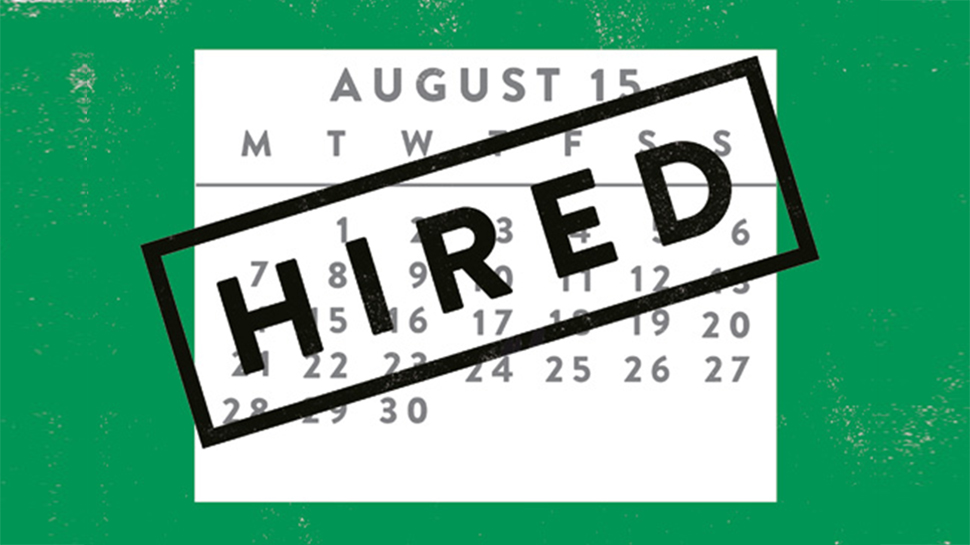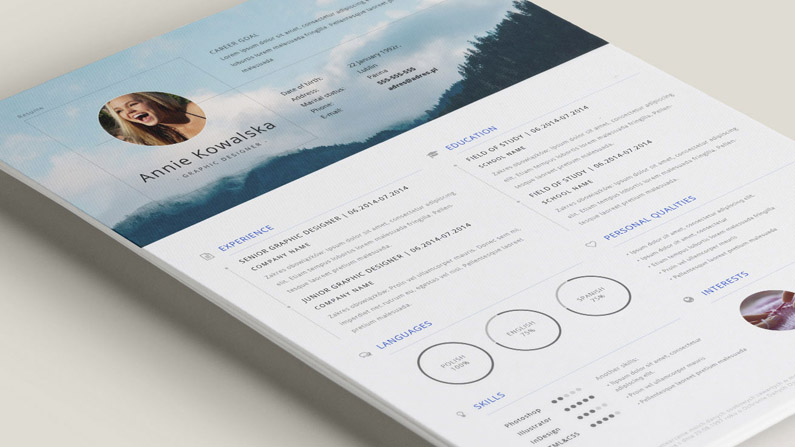how to get a design job
5 golden rules for getting your first design job

Good news if you're looking for your first job as a designer: right now, there are a lot of opportunities out there. So how can you seize these opportunities and land a role as a full-time designer? Having a killer portfolio, a creative resume and nailing tricky interview questions helps, but there are there other tricks, too, that we'll show you.
- 50 brilliant design portfolios to inspire you
"It feels like, in 2017, it's incredibly healthy in design," enthuses Miles Marshall, design director at Turner Duckworth. "Employment is rising. We've taken on more juniors in the last two years than we probably did in the previous five."
It's the same story we're hearing across the industry right now. But before you get too excited, here's the bad news: there's still a heck of a lot of competition out there. "We get applications every single day," says Marshall. "And unless they're from people we've built up relationships with, 99 per cent or more are unsuccessful."
So getting your first design job is still a tough proposition, and many choose to just go freelance instead. But there's much to be said for the financial stability and greater career prospects a salaried job can provide. Here we examine common routes into full-time employment, and how to navigate them, using tips from the pros.
01. Shine in an internship

Once you've completed your design degree and have crafted a great portfolio, it's natural to feel you've earned your right to a salaried role. But the harsh reality is that taking up an internship (or often, a number of internships) is normally the best route towards a full-time position.
That's the case, for example, at The Partners. "The graduates we offer jobs to come through our internship scheme," explains creative director Stuart Radford, who leads the agency's London design team.
"As an intern, you've gone through the process of meeting the designers and presenting your work, so what determines your potential job offer is what you do while you're here. You've got four weeks to make the right impression."
- How to transform a design internship into a job
By that, he doesn't just mean turning up on time and being polite: it's all about exceeding expectations. "Sometimes graduates do what we've asked them to; sometimes they do what we've asked and more," he says, pointedly.
"When a graduate gets into a piece of work and starts to own it, their love of what they do comes through. This can be anything from a few more hours put in to craft a piece of type, or extra thinking they've given to an idea on the bus home. But however it happens, it's always great to see."
You need to be pushy, show you want to get involved and meet clients
David Newton, founder and creative director at Manchester agency BGN, tells a similar tale. "Internships – fully paid, expenses paid, or even the dreaded unpaid – are ultimately a great way of getting a full-time job," he says.
"It's a case of getting your foot in the door and making yourself indispensable. Quite how you do that depends on the agency and their specific needs, but if there's anything you can consistently do, anything that the agency knows they need to do but never seem to have the time to do themselves, that's your in."
That is, of course, easier said than done. It's natural to feel overawed when surrounded by senior designers. And it's tempting to avoid sticking your neck out and suggesting anything too controversial or risky.
But that would be a mistake, says Mark Kemp, owner of FortyTwo Studio, an Aberdeen design agency that takes on a couple of students on placement each year.
"A boss once told me: 'Don't worry about taking on too much responsibility: you'll always be told when you're stepping on toes,' and I've lived by that ever since," he explains.
"So when I bring in an intern, I point to the senior person in the room, and I say, 'Your job here is to get their job. They should be feeling insecure about you coming in.'" You need to be pushy, show you want to get involved and meet clients, says Kemp.
02. Apply for the right jobs

An internship is not the only route into getting a full-time job, of course. It's perfectly possible to apply directly for a role at a company you've had no previous dealings with. But with so many rivals to compete with, success means putting in every ounce of your energy and imagination.
You can start by exercising some empathy. "Put yourself in the shoes of your prospective employer by being tenacious but targeted," advises Lee Hoddy, creative partner at Conran Design Group in London.
"Don't blanket-mail portfolios: create one thoughtful piece to raise eyebrows instead, and turn your CV/resume into a story: selling yourself, not just the work.
"Try writing your profile in 140 characters, leaving the rest as an appendix. Think about structuring your work, interests, motivations and beliefs as a Pinterest page, with neat little moments that will make you stand out," he suggests.
- 30 brilliantly creative resumés
The most important thing is to decide who you really want to work for (rather than just applying for every job going) and tailor your approach accordingly. Once you've nailed that, why not start a conversation with your ideal employer, suggests Newton.
"With portfolio sites and social media, it's much easier to get hold of the people at agencies that you want to speak to – they're just people, after all," he says.
But how best to approach them? "Think of it this way: if your timeline is anything like mine, you'll constantly see creative directors saying which events they're going to," says Newton.
"So go to one, and speak to them in person. You're much more likely to catch them on a good day in those situations. Because, although it sounds like a good idea to rock up at a studio unannounced, at busy times of the year there's nothing more off-putting."
03. Nail the interview

So you've got yourself an interview. Well done. But don't assume you can wing it. You need to think long and hard about how to tell your story, advises David Johnston, co-founder at London design agency Accept & Proceed.
"At interview, we look for people who can articulate their creative process, describe design challenges they've experienced, and explain the rationale behind their creative decisions," he explains.
"Seeing these qualities in young designers gives us the confidence they can grow as part of our team. So where you do have industry experience, demonstrating everything you got out of it is crucial."
- 20 tips for design interview success
Remember, also, that it's not just about you. "Show an interest in the agency by reading its blog and website, getting a taste of the company culture, and asking appropriate questions about it," urges Hoddy.
"You should have a point of view on what you like about the agency, and build a profile in your mind. This demonstrates a curious mindset during interviews and will inform questions to create a richer conversation," he adds.
Don't be too serious, though: being the right 'fit' for a company is also about showcasing your personality and conveying an upbeat attitude.
"Be positive and make sure you smile: this should be an exciting experience that could change your life," says Dorina D'Ambrosio, creative director at Manchester agency The Market Creative.
"Also, have some questions up your sleeve to show you're interested in the job and company. And look smart; although don't look like you're going for an interview at a bank."
Finally, make sure your portfolio has been rigorously honed, says Marshall. "You have to be proud of all the work within it," he says.
"An interviewer can tell when a candidate talks through their portfolio and they're not confident about some of the designs. So it's better to have no fillers and six great pieces of work, rather than six great pieces and three pieces you aren't quite sure of."
04. Work in-house

Most graduates want their first job to be at a traditional design studio, but that's not your only option. What about working client-side as an in-house designer? It should, in theory at least, be easier to get a job this way.
With designers more and more in demand, companies are becoming increasingly pro-active in seeking out talent; looking online, contacting colleges and even turning up to creative events.
However, there are potential downsides. Working in-house will mean you spend your whole time focused on one brand, often under strict guidelines. This may make it difficult to get your next job in a studio, where working for multiple clients and thinking outside the box is the norm.
For this reason, juniors who start in-house tend to stay in-house for much, if not all, of their careers.
That said, Sam Hamrebtan, UK talent lead at Hotwire PR, believes there are many positive reasons to work in-house. "It doesn't really matter where you work, as long as the people you work with push you to create work you're proud of," she argues.
"Plus, working for an in-house team, you may well learn things you wouldn't learn in a traditional design studio where there are a lot more juniors, meaning you have less exposure to seniors who you can learn from," she explains.
Lauren Gibbons, lead designer at PR and communications firm Nelson Bostock, concurs. "In-house does have a bad rap, but I think you actually get a lot more exposure to your projects, and it is what you make it at the end of the day," she says.
It doesn't really matter where you work, as long as the people you work with push you to create work you're proud of
Sam Hamrebtan, Hotwire PR
"So if you can find an in-house role that has potential then you should definitely fly with it."
It's certainly worked for her. "When I joined four-and-a-half years ago, there was no design team so it was a massive punt," she recalls. "But since then I've built up a team of four designers, with an in-house photographer and a video editing team.
"Now, as well as in-house work for Nelson Bostock and Fever PR, I also do creative design work for clients, the likes of Canon, HTC, EE, Google, Playstation and Now TV."
If you do start down the in-house path, though, make sure you're fully committed. Fail to convince recruiters you're serious about an in-house role, and you'll be wasting your time and theirs.
"If, for example, the interests you express on your CV aren't matched by the companies you're actually following and interacting with on LinkedIn, we're going to notice," says Hamrebtan.
Linda Nott, group head of recruitment at marketing agency Hogarth, adds that applicants who apply for hundreds of jobs are often unprepared when they receive a call out of the blue. "We expect people to answer the phone in a professional manner," she explains. "So when they answer, 'Who? Who are you?' it doesn't help convince us they're serious."
05. Don't run back to study

Months have passed, you feel you've tried everything you can, but still you're struggling to get your first job in design. So maybe you should do a post-graduate course; that will get you ahead in the jobs queue... right?
Wrong. "Working in design isn't like working in science or being a doctor, where the more knowledge you have, the better," says Marshall. "Practising design in the field is a much better way to learn, so there's not really any point in doing a post-graduate course, at least in terms of improving your employment opportunities."
Employers will have lots of applications, so don't be too hard on yourself if you don't make it through. Your time will come
Dorina D'Ambrosio, The Market Creative
Yes, such courses do offer you the chance to specialise, says Newton, but he believes that's the wrong way to go about things. "I'd say the better path is to start broad and only worry about niches once you're a few years into your career," he argues.
"Leave university, research design studios, and choose somewhere that will suit you. Then get involved with as much as that studio will let you, to give you a chance of finding something you might want to specialise in.
"And don't worry if you don't want to specialise at all: I never did. If you find you want to boost your knowledge of something – further study in UX, for instance – then by all means do so. But niche, postgraduate study isn't necessary for a first job."
In fact, everyone we asked about this said the same. If you're failing to get your first job, you're better off devoting your energies into working out what you can improve, rather than just retreating back to university. And it may just be a matter of being patient.
"Don't take it personally if your portfolio isn't resonating in the way you would want it to," advises Newton. "It might well be very good technically, but if an agency feels that it doesn't fit, it doesn't fit."
Similarly, D'Ambrosio advises: "Employers will have lots of applications, so don't be too hard on yourself if you don't make it through. Your time will come."
This article originally appeared in Computer Arts issue 269; buy it here !
Related articles:
- Studio vs freelance: The pros and cons
- 20 tips for design interview success
- How to get into design without a degree

Tom May is a freelance writer and editor specialising in design, photography and tech. He is author of Great TED Talks: Creativity, published by Pavilion Books. He has previously been editor of Professional Photography magazine, associate editor at Creative Bloq, and deputy editor at net magazine.
Related articles
how to get a design job
Source: https://www.creativebloq.com/advice/5-golden-rules-for-getting-your-first-design-job
Posted by: garciathervice.blogspot.com

0 Response to "how to get a design job"
Post a Comment